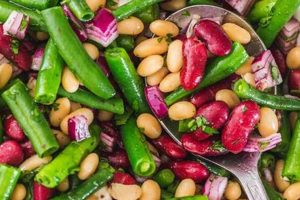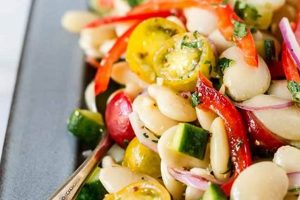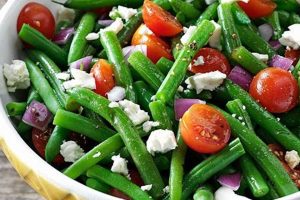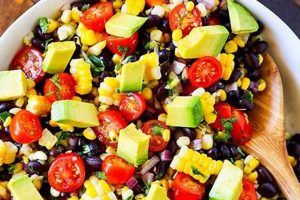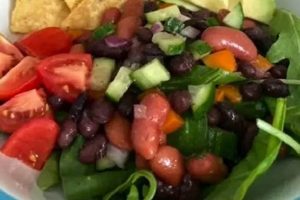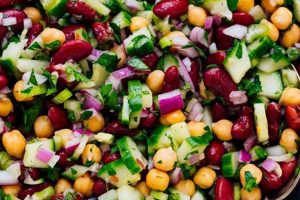Simple bean salad recipes focus on combining various beans, often canned for convenience, with complementary ingredients like vegetables, herbs, and a flavorful dressing. A classic example might include kidney beans, black beans, corn, diced red onion, and a vinaigrette. These recipes prioritize minimal preparation and cooking time, making them ideal for quick meals or side dishes.
The accessibility and nutritional value of bean salads contribute to their popularity. Beans are an excellent source of protein and fiber, promoting satiety and digestive health. Furthermore, the adaptability of these salads allows for customization based on dietary preferences and seasonal availability of produce. Historically, bean salads have evolved from basic combinations to more complex and flavorful variations, reflecting culinary trends and regional influences. Their simplicity also made them a staple in times of economic hardship or when refrigeration was limited.
This exploration will delve into several aspects of creating appealing and healthy bean salads, covering ingredient selection, dressing options, and tips for enhancing flavor and presentation. Specific recipes demonstrating varying levels of complexity will also be provided.
Tips for Easy Bean Salads
Creating flavorful and convenient bean salads involves attention to several key aspects, from ingredient selection to final presentation.
Tip 1: Rinse canned beans thoroughly. This removes excess starch and sodium, resulting in a cleaner flavor and improved texture.
Tip 2: Embrace variety in bean types. Combining different beans adds visual appeal and a broader range of nutrients. Consider kidney, black, pinto, cannellini, or chickpeas.
Tip 3: Select fresh, seasonal vegetables. Crisp vegetables like bell peppers, cucumbers, and red onion provide textural contrast and vibrant color. Adapt choices to seasonal availability for optimal flavor.
Tip 4: Elevate the dressing. A simple vinaigrette is a classic choice, but consider experimenting with herbs, spices, citrus zest, or a touch of Dijon mustard for added complexity.
Tip 5: Don’t overdress the salad. Start with a small amount of dressing and add more as needed. Overdressing can make the salad soggy and mask the flavors of individual ingredients.
Tip 6: Allow flavors to meld. Refrigerate the salad for at least 30 minutes before serving to allow the flavors to blend and deepen.
Tip 7: Consider adding grains or pasta. Cooked quinoa, orzo, or small pasta shapes can transform a simple bean salad into a more substantial meal.
By following these tips, one can create delicious and nutritious bean salads with minimal effort. These versatile dishes offer a convenient and healthy option for lunches, potlucks, or side dishes.
The following section will present several easy-to-follow recipes, illustrating these tips in practice.
1. Canned Beans
Canned beans are fundamental to the ease and accessibility of bean salad recipes. Their pre-cooked state eliminates the need for lengthy soaking and cooking processes, significantly reducing preparation time. This convenience factor makes bean salads a practical option for quick meals or last-minute additions to gatherings. Furthermore, the wide variety of beans available in canned formkidney, black, pinto, cannellini, chickpeas, etc.expands the possibilities for flavor and texture combinations within a single salad. For instance, a three-bean salad capitalizes on this variety by combining kidney, pinto, and green beans for a colorful and texturally diverse dish.
The shelf-stable nature of canned beans contributes to the simplicity of these recipes. Unlike dried beans, which require planning and pre-soaking, canned beans are readily available for immediate use. This aspect simplifies meal planning and makes bean salads a reliable option even with limited time. Moreover, the extended shelf life of canned beans reduces food waste, as they can be stored for extended periods without spoilage. This contributes to both economic efficiency and sustainability in meal preparation. A simple pantry-friendly bean salad, relying solely on canned beans and other shelf-stable ingredients, exemplifies this advantage.
While canned beans provide undeniable convenience, it’s important to acknowledge the potential for higher sodium content. Rinsing canned beans thoroughly under cold water effectively mitigates this issue, removing excess starch and sodium. This step is crucial for maintaining a healthy sodium intake and preserving the desired flavor profile of the salad. Overall, the accessibility, variety, and shelf stability provided by canned beans solidify their role as a cornerstone of easy and efficient bean salad preparation.
2. Quick Preparation
Quick preparation is a defining characteristic of easy bean salad recipes. The ability to assemble a nutritious and flavorful salad within a short timeframe contributes significantly to their appeal, particularly for busy individuals or those seeking convenient meal options. This emphasis on speed and efficiency influences ingredient selection, preparation methods, and overall recipe design.
- Canned Beans:
The use of canned beans eliminates the need for overnight soaking and extended cooking times associated with dried beans. This dramatically reduces preparation time, making it possible to create a bean salad in minutes. Opening, rinsing, and draining canned beans are simple tasks that require minimal effort and contribute significantly to the overall speed of the process. This convenience makes bean salads a practical choice for weeknight meals or impromptu gatherings.
- Pre-chopped Vegetables:
Utilizing pre-chopped vegetables, readily available in most grocery stores, further streamlines the preparation process. While chopping fresh vegetables adds flavor and nutritional value, pre-chopped options offer a significant time-saving advantage. This allows for quick assembly of the salad without compromising on the inclusion of healthy vegetable components. For example, pre-chopped onions, bell peppers, or celery can be readily combined with canned beans and a dressing.
- Simple Dressings:
Easy bean salad recipes often feature simple dressings that require minimal whisking or blending. A basic vinaigrette, composed of oil, vinegar, and seasonings, can be prepared in seconds. More complex dressings can also be made quickly by combining readily available ingredients such as bottled sauces, herbs, and spices. The focus remains on efficiency without sacrificing flavor.
- No-Cook Recipes:
The absence of cooking requirements in many bean salad recipes contributes substantially to their quick preparation. Combining canned beans, pre-chopped vegetables, and a prepared dressing eliminates the need for stovetop or oven use. This not only saves time but also reduces cleanup, further enhancing the convenience factor. This characteristic makes bean salads ideal for warm weather, when minimizing heat in the kitchen is desirable.
The convergence of these elementscanned beans, pre-chopped vegetables, simple dressings, and no-cook preparationdefines the quick and easy nature of these salads. This efficiency allows for the creation of nutritious, flavorful meals with minimal time investment, making bean salads a practical and appealing option for a variety of occasions.
3. Versatile Ingredients
The versatility of ingredients plays a crucial role in the enduring popularity of easy bean salad recipes. This adaptability allows for customization based on individual preferences, dietary restrictions, seasonal availability, and creative exploration. The ability to incorporate a wide range of components contributes to the appeal of bean salads as a flexible and convenient meal option.
- Beans:
While canned beans provide the foundation for ease and efficiency, the variety of bean types available offers significant flexibility. Kidney, black, pinto, cannellini, chickpeas, and many others can be incorporated, each contributing unique flavor and textural nuances. This allows for endless combinations and ensures that recipes can be tailored to specific preferences. A simple substitution of black beans for kidney beans, for example, can create a distinctly different flavor profile.
- Vegetables:
The inclusion of vegetables expands both the nutritional value and the flavor possibilities of bean salads. From crisp cucumbers and bell peppers to pungent red onions and earthy corn, a wide range of vegetables complements the heartiness of beans. Seasonal variations allow for ongoing exploration and adaptation, utilizing fresh produce for optimal flavor. A summer bean salad might feature fresh tomatoes and corn, while a winter version could incorporate roasted root vegetables.
- Grains and Pasta:
Incorporating grains or pasta transforms a simple bean salad into a more substantial meal. Quinoa, orzo, couscous, or small pasta shapes add textural complexity and increase the overall satiety of the dish. This adaptability allows bean salads to function as either a light side dish or a complete meal, depending on individual needs and preferences. Adding cooked orzo to a Mediterranean-inspired bean salad elevates it to a main course option.
- Dressings:
Dressings contribute significantly to the overall flavor profile of bean salads. While a simple vinaigrette is a classic choice, the possibilities for customization are extensive. Herbs, spices, citrus zest, different types of oil and vinegar, and various flavor enhancers can be incorporated to create unique and complementary dressings. A southwestern-style bean salad might benefit from a lime-cilantro dressing, while a Mediterranean version could feature a lemon-herb vinaigrette.
This inherent versatility distinguishes easy bean salad recipes as adaptable and accommodating dishes, suitable for a variety of occasions and dietary needs. The ability to seamlessly incorporate different ingredients expands the possibilities for flavor combinations and ensures that bean salads remain a consistently appealing and convenient meal option.
4. Flavorful Dressings
Flavorful dressings are essential for elevating simple bean salad recipes from basic to exceptional. While the ease of preparation remains a priority, the dressing provides the opportunity to introduce complexity, depth, and balance to the overall flavor profile. The right dressing can transform a collection of beans and vegetables into a cohesive and satisfying dish.
- Balancing Acidity:
Acidity plays a crucial role in brightening the flavors of a bean salad and cutting through the richness of the beans. Vinegar, citrus juice, or a combination of both are common acidic components in dressings. The level of acidity should be carefully balanced to complement the other ingredients without overpowering them. A lemon vinaigrette, for example, provides a refreshing tang to a white bean salad, while a lime-based dressing enhances the flavors of a southwestern black bean salad.
- Enhancing with Herbs and Spices:
Fresh or dried herbs and spices contribute significantly to the complexity and depth of flavor in bean salad dressings. From the bright, herbaceous notes of parsley and cilantro to the warm, earthy tones of cumin and chili powder, the selection of herbs and spices can dramatically alter the overall taste profile. A Mediterranean-inspired bean salad might benefit from oregano and mint, while a Tex-Mex version could incorporate cumin, chili powder, and smoked paprika.
- The Role of Oil:
Oil provides richness, texture, and a medium for carrying the flavors of other ingredients in the dressing. Olive oil is a common choice, offering a fruity and slightly peppery flavor. Other oils, such as avocado or grapeseed oil, can also be used to achieve different flavor profiles and health benefits. The type of oil selected should complement the other ingredients and contribute to the overall balance of the dressing.
- Building Complexity with Flavor Enhancers:
Flavor enhancers add depth and complexity to bean salad dressings beyond the basic elements of acid, herbs, spices, and oil. Ingredients such as Dijon mustard, minced garlic, or a touch of honey or maple syrup can introduce subtle nuances that elevate the overall flavor profile. A Dijon vinaigrette, for example, adds a tangy and slightly spicy dimension to a classic bean salad.
The careful consideration of these elementsbalancing acidity, incorporating herbs and spices, selecting the appropriate oil, and utilizing flavor enhancersallows for the creation of dressings that not only complement the simplicity of bean salad recipes but also elevate them to flavorful and satisfying dishes. This balance of ease and flavor enhancement is key to the enduring appeal of bean salads as a versatile and convenient meal option.
5. Minimal Cooking
Minimal cooking is intrinsic to the concept of “bean salad recipes easy,” directly contributing to their convenience and accessibility. The absence of elaborate cooking processes significantly reduces preparation time and simplifies the overall recipe execution. This characteristic makes bean salads an ideal choice for quick meals, particularly when time is limited or culinary skills are less developed. The following facets explore the connection between minimal cooking and the ease of bean salad preparation.
- Canned Beans as a Foundation:
Canned beans eliminate the need for the lengthy soaking and cooking processes typically required for dried beans. Their pre-cooked state allows for immediate incorporation into the salad, drastically reducing overall preparation time. This convenience is paramount to the “easy” aspect of these recipes, making them accessible to a wider range of individuals, regardless of cooking experience.
- Emphasis on Fresh, Raw Ingredients:
Many bean salad recipes emphasize the use of fresh, raw vegetables such as bell peppers, cucumbers, onions, and tomatoes. These ingredients require no cooking, further minimizing preparation time and effort. This focus on raw components also preserves the nutritional value of the vegetables and contributes to the overall freshness and vibrancy of the salad.
- Simplified Dressings:
Dressings for easy bean salads typically involve minimal preparation, often consisting of a simple whisk of oil, vinegar, and seasonings. The absence of cooked components in the dressing further streamlines the process, reinforcing the minimal cooking aspect. This simplicity aligns with the overall ease and convenience of the recipe.
- Occasional Exceptions and Adaptations:
While minimal cooking is a defining characteristic, some bean salad recipes may incorporate cooked elements, such as roasted vegetables or grains. However, even in these instances, the cooking processes are typically straightforward and brief, preserving the overall ease of preparation. Roasted sweet potatoes or cooked quinoa, for example, can enhance the flavor and nutritional profile without significantly increasing complexity.
The minimal cooking aspect of easy bean salad recipes is a key factor in their widespread appeal. By minimizing or eliminating cooking processes, these recipes offer a convenient and accessible pathway to creating nutritious and flavorful meals. This emphasis on simplicity empowers individuals with varying levels of culinary expertise to enjoy the benefits of bean-based dishes without extensive time commitments or complex techniques.
6. Healthy Options
The inherent nutritional value of beans positions “healthy options” as a central theme within the context of easy bean salad recipes. Beans are naturally rich in protein and fiber, two essential nutrients that contribute significantly to satiety and digestive health. Protein supports muscle growth and repair, while fiber promotes regularity and helps manage cholesterol levels. These inherent health benefits provide a strong foundation for creating nutritious meals with minimal effort, aligning seamlessly with the “easy” aspect of these recipes. A simple black bean salad, for example, provides a substantial dose of both protein and fiber, contributing to a feeling of fullness and supporting overall well-being.
Beyond the nutritional contributions of beans themselves, easy bean salad recipes offer further opportunities for incorporating healthy options. The inclusion of fresh vegetables increases the vitamin, mineral, and antioxidant content of the dish. Colorful vegetables like bell peppers, tomatoes, and spinach contribute essential micronutrients and enhance the nutritional profile of the salad. Furthermore, choosing healthy fats for the dressing, such as olive oil or avocado oil, provides beneficial monounsaturated fats and avoids less healthy options like saturated or trans fats. A Mediterranean-inspired bean salad with olive oil, tomatoes, cucumbers, and feta cheese exemplifies the integration of various healthy components.
The ease of preparation inherent in these recipes reinforces the accessibility of healthy eating. The minimal cooking and reliance on readily available ingredients, such as canned beans and fresh produce, removes barriers to incorporating nutritious meals into daily routines. This convenience factor is particularly significant for individuals with limited time or culinary skills. By emphasizing simplicity and nutritional value, easy bean salad recipes empower individuals to prioritize healthy choices without significant effort. This accessibility underscores the practical significance of understanding the connection between “healthy options” and “bean salad recipes easy” in promoting overall well-being.
7. Adaptable Recipes
Adaptability is a defining characteristic of easy bean salad recipes, significantly contributing to their versatility and enduring appeal. This inherent flexibility stems from the capacity to modify ingredients and flavors based on individual preferences, dietary needs, seasonal availability, and creative culinary exploration. The connection between “adaptable recipes” and “bean salad recipes easy” lies in the simplicity of the base formula, which allows for effortless customization without compromising the core principles of convenience and minimal preparation.
The foundational structure of a bean saladbeans, vegetables, and dressingprovides a blank canvas for culinary improvisation. Substituting different bean varietiesblack beans for kidney beans, chickpeas for cannellini beansalters the flavor profile and nutritional composition without requiring significant adjustments to the recipe. Similarly, seasonal vegetables can be readily incorporated, allowing for continuous adaptation throughout the year. A spring bean salad might feature fresh asparagus and peas, while a fall version could incorporate roasted butternut squash and cranberries. This adaptability extends to the dressing as well, where variations in oil, vinegar, herbs, and spices create unique flavor profiles that complement the chosen ingredients. A simple vinaigrette can be transformed with the addition of Dijon mustard, honey, or a blend of fresh herbs.
The practical significance of this adaptability lies in its ability to cater to a wide range of dietary preferences and restrictions. Vegetarian and vegan versions are easily achieved by focusing on plant-based ingredients, while gluten-free options can be created by selecting appropriate grains or omitting them altogether. Furthermore, ingredient substitutions can accommodate food allergies or sensitivities, ensuring that individuals with specific dietary needs can enjoy the benefits of bean salads. This inherent adaptability also promotes creativity and experimentation in the kitchen, encouraging culinary exploration without the constraints of rigid recipes. The simplicity of the base formula empowers individuals to personalize their bean salads, creating dishes that reflect individual tastes and preferences. This capacity for customization solidifies the connection between “adaptable recipes” and “bean salad recipes easy,” underscoring their practical value and enduring appeal in diverse culinary contexts.
Frequently Asked Questions
This section addresses common inquiries regarding easy bean salad recipes, providing concise and informative responses to clarify potential uncertainties and enhance understanding of this versatile dish.
Question 1: How long can bean salad be stored in the refrigerator?
Properly stored bean salad typically lasts for 3-5 days in the refrigerator. Ensure the salad is stored in an airtight container to maintain freshness and prevent absorption of odors from other foods.
Question 2: Can dried beans be used instead of canned beans?
Dried beans can be used, but require pre-soaking and cooking before inclusion in the salad. This increases preparation time significantly. If using dried beans, ensure they are fully cooked until tender.
Question 3: How can sodium content be reduced in bean salad?
Rinsing canned beans thoroughly under cold water significantly reduces sodium content. Additionally, using low-sodium or no-salt-added canned beans further minimizes sodium intake. Controlling the amount of salt added to the dressing also contributes to sodium reduction.
Question 4: What are some ways to enhance the flavor of a simple bean salad?
Flavor can be enhanced through various methods. Incorporating fresh herbs like parsley, cilantro, or mint adds brightness. Spices such as cumin, chili powder, or paprika introduce warmth and complexity. Flavorful additions like chopped red onion, bell peppers, or roasted garlic also elevate the taste profile.
Question 5: Can bean salad be frozen?
While freezing is possible, it’s generally not recommended. Freezing can negatively impact the texture of the beans and vegetables, resulting in a less appealing final product upon thawing. It’s best to prepare and consume bean salad within the recommended refrigeration timeframe.
Question 6: How can bean salad be adapted for different dietary needs?
Bean salad adapts readily to various dietary requirements. For vegan or vegetarian diets, ensure all ingredients, including the dressing, are plant-based. Gluten-free versions can be created by avoiding gluten-containing grains or using gluten-free alternatives. Ingredient substitutions can also accommodate specific food allergies or sensitivities.
Understanding these common inquiries facilitates successful preparation and enjoyment of easy bean salad recipes. These versatile dishes offer a convenient and nutritious option for various occasions, adaptable to individual preferences and dietary needs.
The following section will offer a curated selection of easy bean salad recipes, demonstrating the practical application of the information presented thus far.
Conclusion
Simple bean salad recipes offer a convenient and nutritious approach to meal preparation. The emphasis on minimal cooking, readily available ingredients, and adaptable flavors aligns with the demand for efficient and healthy meal options. The exploration of ingredient versatility, dressing options, and the nutritional benefits of beans underscores the value of these recipes in diverse culinary contexts. The ease of preparation, combined with the adaptability to various dietary needs and preferences, positions bean salads as a practical and appealing choice for individuals seeking both convenience and nutritional value.
The potential for culinary creativity within the framework of simple bean salad recipes remains vast. Continued exploration of flavor combinations, ingredient variations, and presentation styles can further elevate the status of this humble dish. Embracing the adaptability inherent in these recipes empowers individuals to personalize their culinary experiences while prioritizing both ease of preparation and nutritional well-being. Bean salads represent a readily accessible pathway to healthy and flavorful meals, offering a practical solution for the demands of modern lifestyles.

